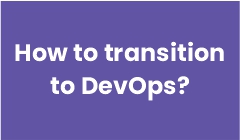
In today’s fast-moving software world, many developers are asking a crucial career question: Can I switch from development to DevOps?
The short answer is yes — absolutely. Transitioning from software development to DevOps is not only possible but also one of the most rewarding and future-proof moves you can make in 2025. As companies around the world adopt cloud computing, continuous integration, and automation-driven development, DevOps engineers are among the most in-demand professionals in India and globally.
This guide will help you understand why this transition is important, how to make it successfully, what skills you need to learn, and which steps can fast-track your journey from developer to DevOps engineer.
Why Developers Are Moving Toward DevOps
If you’ve been coding applications for years, you may wonder why so many developers are switching to DevOps. The answer lies in how modern software delivery has evolved.
Key reasons developers transition to DevOps:
In short: the line between development and operations has blurred — making DevOps the next logical step in your software career.
Understanding DevOps Before the Switch
Before deciding to switch from development to DevOps, it’s important to understand what DevOps actually is.
DevOps is not just a job title — it’s a culture, mindset, and methodology that combines software development (Dev) and IT operations (Ops) to enable faster, reliable, and continuous delivery of software.
It emphasizes:
If you already work in software development, you’ve mastered one half of DevOps — the “Dev” side. Your next step is to learn the “Ops” side and integrate both for complete lifecycle ownership.
Is It Easy to Switch from Development to DevOps?
Switching from development to DevOps is easier than you think—especially because developers already have a strong foundation in logic, coding, and problem-solving.
However, the transition requires:
If you are ready to learn new technologies and embrace automation, you can smoothly transition from developer to DevOps engineer within 3–6 months of focused learning.
Skills You Need to Switch from Development to DevOps
As a developer, you already possess strong coding fundamentals. But to successfully transition, you need to build a complementary skill set around DevOps tools, cloud platforms, and automation.
Key skills to learn for a smooth DevOps transition:
1. Programming & Scripting
Continue improving your core programming language (Java, Python, or JavaScript).
Also, learn scripting languages like Bash, Shell, or Python for automation.
2. Version Control (Git)
Master Git and branching strategies for collaborative workflows. Learn how Git integrates with CI/CD tools like Jenkins or GitHub Actions.
3. CI/CD Pipelines
Learn how to automate build, test, and deployment using:
4. Containers & Orchestration
Understand how applications are containerized using Docker, and managed at scale with Kubernetes.
5. Infrastructure as Code (IaC)
Learn to manage servers and environments through code using:
6. Cloud Platforms
Hands-on experience with AWS, Azure, or Google Cloud Platform (GCP) is essential for deploying scalable applications.
7. Monitoring & Observability
Familiarize yourself with monitoring tools such as Prometheus, Grafana, ELK Stack, or CloudWatch for performance insights.
8. Security Integration (DevSecOps)
Learn how to integrate security practices within pipelines — scanning, compliance, and role-based access controls.
9. Collaboration Tools
Work with tools like Slack, JIRA, and Confluence to improve team communication and project tracking.
Step-by-Step Roadmap: How to Move from Developer to DevOps
If you’re wondering how to switch from development to DevOps practically, follow this structured roadmap. It’s designed for developers in India aiming for 2025-ready DevOps roles.
Step 1: Assess Your Current Skills
Step 2: Learn the DevOps Fundamentals
Step 3: Practice with Real Tools
Hands-on learning is key to your success.
Step 4: Learn Cloud Deployment
Use AWS Free Tier or Azure Sandbox to practice:
Step 5: Work on Real Projects
Step 6: Get Certified (Optional but Helpful)
Certifications validate your DevOps skills.
Step 7: Apply DevOps Practices at Work
Even in your current developer job, start adopting DevOps practices:
By doing so, you’ll naturally evolve from developer to DevOps professional.
Common Challenges When Switching to DevOps
Transitioning from development to DevOps can come with learning hurdles. Knowing them early helps you plan effectively.
Typical challenges include:
How to overcome them:
How Long Does It Take to Switch from Development to DevOps?
The time required to switch depends on your existing experience, learning speed, and project exposure.
By investing 10–12 hours per week in learning, hands-on practice, and real-world projects, you can confidently transition to DevOps within a short time.
The Career Benefits of Moving from Development to DevOps
Switching from development to DevOps opens up new opportunities for faster growth, higher salaries, and global job prospects.
Top benefits include:
Realistic Career Path After Transition
Once you successfully switch from development to DevOps, several growth paths open up:
| Career Stage | Role Title | Key Focus Areas |
|---|---|---|
| Entry Level | Junior DevOps Engineer | Learning tools, CI/CD, automation |
| Mid-Level | DevOps Engineer | Managing pipelines, containers, cloud |
| Advanced | Senior DevOps Engineer | Infrastructure design, monitoring |
| Expert | DevOps Architect / SRE | Automation strategy, reliability, scalability |
| Leadership | DevOps Manager / Head of Engineering | Driving DevOps adoption, mentoring teams |
Tools Every Developer Must Know Before Switching
To confidently make the move from developer to DevOps, master the following tools step by step:
Mastering these tools through hands-on practice helps build a solid foundation for your DevOps career.
Mindset Shift: From Developer to DevOps Engineer
The most important part of the transition is mindset change.
As a developer, you might focus primarily on coding features and fixing bugs. In DevOps, you think beyond the code — you think about automation, scalability, security, and performance.
Key mindset transformations required:
In short, the DevOps mindset is all about continuous improvement, shared responsibility, and proactive problem-solving.
How to Present Your DevOps Transition to Employers
Once you acquire skills and experience, it’s important to position yourself effectively for DevOps roles.
Tips to highlight your transition in your resume and interviews:
Employers value developers who have transitioned because they combine deep coding knowledge with infrastructure automation expertise.
DevOps Careers in India (2025)
In the Indian IT job market, DevOps is one of the top 3 fastest-growing IT roles for 2025.
Cities like Hyderabad, Bengaluru, Pune, and Chennai lead in DevOps hiring for product companies, MNCs, and startups.
Market Insights:
By mastering DevOps now, you position yourself for global remote opportunities as well.
Common Myths About Switching to DevOps
Myth 1: You must be an operations expert before moving to DevOps.
Reality: Developers already have the most important skills — coding and problem-solving. Ops skills can be learned gradually.
Myth 2: DevOps is only about tools.
Reality: Tools are secondary; collaboration, mindset, and process automation are primary.
Myth 3: It’s hard to find DevOps jobs without certification.
Reality: Practical skills and project portfolios often outweigh certifications.
Myth 4: DevOps eliminates the need for developers.
Reality: DevOps enhances developer roles — you become a more versatile engineer.
Action Plan to Start Your DevOps Journey
Here’s a 90-day practical roadmap for developers ready to switch:
Day 1–30: Learn Fundamentals
Day 31–60: Build Automation Skills
Day 61–90: Implement Projects
By following this structured plan, you’ll be job-ready within 3 months.
Final Takeaway
So, can you switch from development to DevOps?
Yes — and it’s one of the smartest career decisions you can make in 2025.
DevOps empowers developers to take control of the entire software lifecycle — from writing code to deploying, monitoring, and scaling applications. It enhances your technical profile, increases your value in the job market, and gives you the freedom to work across multiple cloud and automation technologies.
Key reminders before you begin:
By following this roadmap and continuously improving, you’ll soon go from “just a developer” to a high-impact DevOps engineer shaping the future of software delivery.

1. Understand the DevOps Mindset
Before you can successfully transition to DevOps, you must shift from a siloed, task-based mindset to a collaborative, end-to-end mindset.
Key mindset elements to adopt
In short: you’re moving from “I write code and hand off” to “I build, deploy, monitor and improve.”
Why mindset matters in a DevOps transition
So your first step in the journey of how to transition to DevOps is to mentally prepare for this shift.
2. Assess Your Current Role, Skills & Gap
To map an effective path for how to transition to DevOps, you need to know where you’re starting from.
Self-assessment questions
Identify the gap
Once you know where you are, identify what you lack and what you need to acquire in order to transition. For example:
This gap analysis is the core of your personal roadmap for how to transition to DevOps.
3. Define a Learning Roadmap for DevOps Transition
Once you know your current state and gap, construct a structured roadmap with milestones for how to transition to DevOps.
High-level roadmap phases
Sample milestone list
Why a roadmap helps
4. Acquire Key Skills & Tools for DevOps
At the heart of “how to transition to DevOps” is mastering both technical and soft skills. The more you build competence here, the more confident your transition.
Technical skills to focus on
Soft skills & culture skills
How to learn and demonstrate these skills
5. Navigate the Transition from Your Current Role
Whether you come from development, QA, system administration or support, you’ll need a strategy to move into a DevOps role. This is the “how to transition to DevOps” in action.
From Developer → DevOps
If you're a software developer, you already know coding and build/test practices. Focus on:
From QA/Tester → DevOps
If you’re in QA or testing:
From System/Network Admin or Support → DevOps
If you come from operations or support:
“Start off with learning a cloud technology -> Linux basics -> Terraform -> Docker -> Kubernetes. … It took me about 1 year to land devops job.”
Tips for internal transitions
6. Build Your Portfolio & Demonstrate Value
A key part of how to transition to DevOps is proving your skills—not just saying you know tools but showing you’ve delivered results.
Elements of a strong DevOps portfolio
Why this matters
7. Overcome Common Challenges in the DevOps Transition
Transitioning to DevOps isn’t trivial—many face stumbling blocks. Understanding these challenges helps you plan better.
Common challenges
How to mitigate these challenges
8. Align with Your Geographic & Industry Context
Given you are in Hyderabad, Telangana (India) and likely targeting learners in India and global remote opportunities, here are some location- and industry-specific considerations when you transition to DevOps.
Indian market context
Industry verticals
9. Certifications, Training & Your Next Action Plan
To support your transition to DevOps, structured training and certifications can help—but they are not the only path. Your action plan must combine formal learning + hands-on projects.
Certifications & training to consider
Creating your action plan (30-60-90 days)
First 30 days:
Next 30 days (Day 31–60):
Next 30 days (Day 61–90):
Why this plan works
10. Measuring Success & Long-Term Growth
Transitioning to DevOps isn’t just a one-time shift—it’s a career journey. It’s crucial to measure how far you’ve come and plan for continuous growth.
Metrics to track for your transition
Long-term growth path in DevOps
Once you’ve successfully transitioned to a DevOps role, consider next-level roles:
Keep your learning alive
Final Thoughts
To summarise, if you’re committed to transitioning to DevOps, here’s your checklist:
By following this roadmap and commitment, you can confidently answer the question of how to transition to DevOps with clarity, structure, and impact. For learners in Hyderabad, Telangana, or across India, this approach bolsters both your technical credibility and employability in the evolving software industry.

DevOps is one of the most sought-after and dynamic professions in the IT sector. Most students who want to pursue this field often have one question in common: "Is DevOps need coding?" or "Do I need to learn coding to study DevOps?" The answer lies in the sphere of DevOps where you wish to specialize.
In this comprehensive guide, we’ll explore whether coding is necessary in DevOps, how much programming knowledge is required, the tools and technologies that make DevOps work, and how non-coders can still build a successful DevOps career.
Understanding What DevOps Is
Before answering whether DevOps requires coding, it’s essential to understand what DevOps actually means.
DevOps is an amalgamation of Development (Dev) and Operations (Ops) that tries to bridge the collaboration gap between software development and IT operations teams. DevOps focuses on automation, collaboration, and continuous integration and delivery (CI/CD) to deliver software more quickly and with greater reliability.
Principal Goals of DevOps:
Does DevOps Require Coding?
The simple answer:
➡️ You'll need some basic coding skills, but you don't need to be a super-duper programmer.
DevOps is a mix of technical capabilities and automation methodologies. Some positions in DevOps do need scripting and coding, but others are based on infrastructure management, automation tools, monitoring, and deployment, where profound coding skills are not always necessary.
If you have a skillset to read, write, and tweak simple code or scripts, you'll be well-placed to undertake most DevOps activities.
Why Coding Is Important in DevOps
The following are the main reasons why coding is helpful in DevOps:
Automation:
DevOps relies extensively on automation. Tasks such as deployment, configuration, and monitoring are done with scripts that automate them.
Configuration Management:
Such tools as Ansible, Puppet, and Chef leverage coding-like syntax or YAML scripts for managing infrastructure.
CI/CD Pipelines:
Creating and maintaining Continuous Integration and Continuous Deployment pipelines often involves writing configuration files and scripts.
Infrastructure as Code (IaC):
Tools like Terraform and CloudFormation require coding logic to define and manage infrastructure resources.
Custom Integrations:
Sometimes, you’ll need to write custom scripts in Python, Shell, or Groovy to integrate systems or tools.
How Much Coding Is Required in DevOps?
You don't have to be a master of full-scale software development. Scripting languages and automation methods are the emphasis instead.
Standard Coding and Scripting Skills for DevOps Engineers:
Tip: You don't have to be a software coder; you just need to know how to apply code for automating processes.
DevOps Job Roles That Involve Minimum Coding
Not every DevOps role requires high-level coding expertise. Some roles lean more toward being tool-focused and process-focused.
1. DevOps Engineer (Tool Specialist):
2. Cloud DevOps Engineer:
3. Release Manager:
4. Site Reliability Engineer (SRE):
5. Security & Compliance Automation (DevSecOps):
DevOps Tools You Can Use Without Deep Coding Knowledge
Current DevOps is greatly dependent on automation tools that reduce the need for writing code manually.
The following are the easiest DevOps tools for beginners:
Learning DevOps Without a Programming Background
As a non-coder newcomer, you can still learn DevOps effectively.
Step-by-Step Roadmap for Non-Coders:
Can You Become a DevOps Engineer Without Coding?
Yes, you can!
You can work as a DevOps Engineer without good coding skills by concentrating on tools, system administration, and automating processes. You can learn coding gradually in the long run to advance your skills.
Most successful DevOps engineers started without any programming experience — they learned automation and scripting in increments along with tools such as Docker, Jenkins, and Terraform.
Core Skills Necessary for a Career in DevOps
In addition to coding, a DevOps engineer requires some non-coding skills that are just as crucial:
Networking basics
Why DevOps Is a Great Career Option
Global demand is increasing for DevOps engineers. Organizations are embracing DevOps to automate processes and speed up product delivery.
Top Reasons to Choose DevOps as a Career:
Common Myths About DevOps and Coding
| Myth | Reality |
|---|---|
| DevOps is only for coders | False — you can learn DevOps without strong coding skills. |
| DevOps is a single tool | False — it’s a combination of tools, practices, and culture. |
| Automation means no coding | Partly true — basic scripting is still required for automation. |
| DevOps is only for developers | False — system admins, testers, and cloud engineers can become DevOps professionals. |
Best Way to Start Learning DevOps
If you want to seriously start a DevOps career, here is the strategy:
Conclusion
So, does DevOps need coding?
✅ The answer is yes, but only to a basic extent.
You don't necessarily need to be a developer to embark on a career in DevOps. Strong knowledge of automation, tools, scripting, and cloud technologies can get you started. With time, knowing easy programming languages like Python or Bash will increase your efficiency and value.
Irrespective of whether you are new to everything, a system admin, or a cloud expert, you can seamlessly transition into a DevOps career with adequate training and hands-on experience.